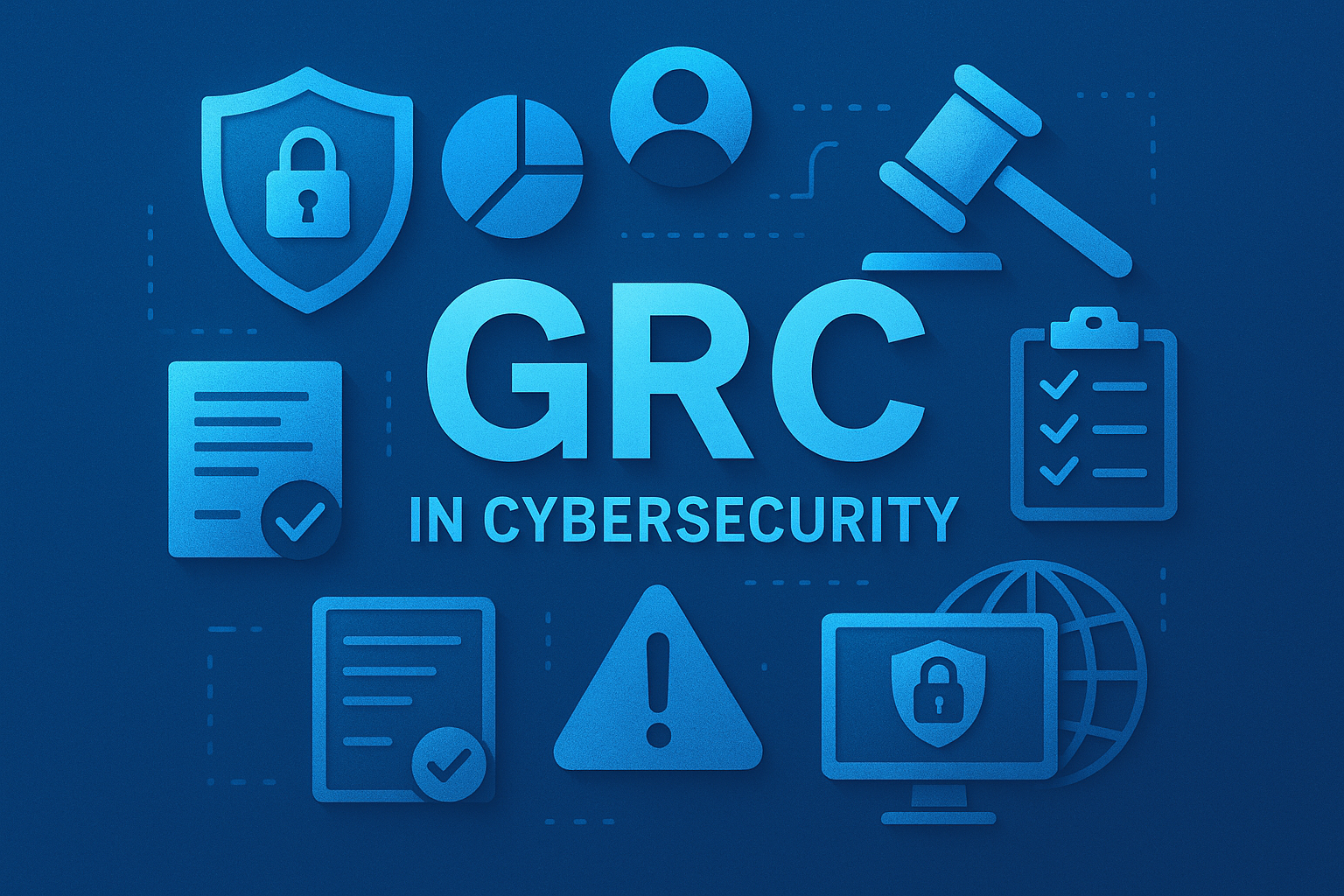Introduction
Cybersecurity has evolved into one of the most critical areas of focus for organisations worldwide. With rising threats ranging from ransomware to state-sponsored cyber attacks, businesses, governments, and individuals face immense risks. But securing digital assets is not just about deploying firewalls, encryption, or intrusion detection systems. It’s about aligning technology with governance, risk, and compliance (GRC).
GRC in cybersecurity provides the strategic backbone for building resilience. It ensures that security measures are not implemented in silos but integrated with organisational goals, regulatory requirements, and risk management practices. This article explores the role of GRC in cybersecurity and provides a road map for individuals and organisations looking to embark on the GRC journey.
What is GRC in Cybersecurity?
GRC stands for Governance, Risk, and Compliance. In the context of cybersecurity:
- Governance is about decision-making and oversight. It ensures cybersecurity efforts align with organisational goals, policies, and ethical standards.
- Risk Management identifies, assesses, and mitigates cybersecurity threats to ensure business continuity.
- Compliance ensures that the organisation meets internal policies and external legal, regulatory, and industry requirements.
Together, these three pillars create a structured framework that bridges business operations with cybersecurity. Rather than treating cybersecurity as a purely technical function, GRC integrates it into the organisation’s strategic vision.
Why GRC Matters in Cybersecurity
1. Aligns Security with Business Objectives
Cybersecurity is often seen as a cost centre, but GRC shifts the perspective. It ensures cybersecurity programs support organisational objectives such as protecting intellectual property, maintaining customer trust, and ensuring operational resilience.
2. Helps Navigate Complex Regulations
Organisations operate under a web of regulations such as GDPR, HIPAA, SOX, CCPA, PCI DSS, and ISO 27001. GRC frameworks help organisations keep pace with these requirements, avoid penalties, and maintain certifications.
3. Provides a Risk-Based Approach
Instead of blanket security measures, GRC promotes a risk-based approach. This means resources are prioritised based on the severity and likelihood of threats, making cybersecurity more effective and cost-efficient.
4. Strengthens Incident Response and Recovery
With GRC, incident response plans are not just technical playbooks but organisational strategies involving communication, legal considerations, and stakeholder management.
5. Enhances Stakeholder Confidence
Investors, regulators, and customers want assurance that their data is safe. A strong GRC posture demonstrates proactive risk management and compliance, strengthening trust and reputation.
The Core Components of GRC in Cybersecurity
- Policies and Procedures
- Establishing clear cybersecurity policies that define acceptable use, access control, data protection, and incident management.
- Risk Assessments
- Conducting regular risk assessments to identify vulnerabilities and threats to IT systems and data.
- Controls and Safeguards
- Implementing technical and administrative controls such as encryption, access management, and audit trails that reduce cyber risks.
- Regulatory Compliance Monitoring
- Ensuring continuous compliance with industry-specific standards and conducting internal audits to verify adherence.
- Incident Response Planning
- Building robust incident response frameworks that combine governance with real-time detection and mitigation strategies.
- Continuous Monitoring and Reporting
- Leveraging GRC tools to monitor risks, track compliance, and provide dashboards for executives and regulators.
How GRC Transforms Cybersecurity Programs
Many organisations implement cybersecurity in a reactive manner, deploying solutions only after a breach occurs. GRC changes this by embedding proactive governance and accountability. Here’s how:
- From reactive to proactive: Risk-based governance anticipates threats rather than waiting for incidents.
- From isolated to integrated: GRC integrates cybersecurity across all departments, not just IT.
- From compliance-driven to resilience-driven: Compliance is necessary, but resilience ensures organisations survive and thrive after incidents.
Challenges in Implementing GRC in Cybersecurity
While the benefits are clear, organisations face several challenges:
- Complexity of Regulations: Keeping up with constantly evolving laws and standards.
- Resource Constraints: Smaller organisations may lack staff or budget to establish a comprehensive GRC program.
- Cultural Resistance: Employees may see GRC controls as restrictive or unnecessary.
- Integration Issues: Aligning GRC tools with existing IT infrastructure can be difficult.
- Dynamic Threat Landscape: Cyber risks evolve faster than governance and compliance frameworks.
Overcoming these requires leadership commitment, investment in training, and the use of advanced GRC tools.
How to Start on the Path of GRC in Cybersecurity
Whether you’re an individual professional or an organisation, here’s a road map to get started.
Step 1: Understand the Basics of GRC
- Read about governance frameworks like COBIT, ISO 27001, and the NIST Cybersecurity Framework.
- Learn compliance requirements relevant to your industry, such as HIPAA for healthcare or PCI DSS for payments.
Step 2: Build a Governance Structure
- Create a cybersecurity steering committee.
- Define roles and responsibilities for risk and compliance management.
- Establish reporting lines to executives and the board.
Step 3: Conduct a Risk Assessment
- Identify critical assets such as data, applications, and infrastructure.
- Evaluate threats like malware, phishing, insider threats, and supply chain attacks.
- Assign risk levels and prioritise mitigation measures.
Step 4: Develop Policies and Procedures
- Create cybersecurity policies covering data protection, incident management, vendor management, and user access.
- Train employees on these policies regularly.
Step 5: Ensure Compliance
- Map current security practices to regulatory requirements.
- Conduct gap analyses to identify areas of non-compliance.
- Implement corrective actions and prepare for audits.
Step 6: Adopt GRC Tools and Technologies
- Use platforms like RSA Archer, ServiceNow GRC, or MetricStream for centralized risk, compliance, and governance management.
- Integrate with SIEM systems for real-time monitoring.
Step 7: Build Incident Response and Recovery Plans
- Define roles, escalation paths, and communication channels.
- Conduct tabletop exercises and simulations to test preparedness.
Step 8: Promote a Security Culture
- Engage employees through cybersecurity awareness training.
- Foster accountability at all levels, from executives to end users.
Step 9: Continuous Monitoring and Improvement
- Regularly review and update risk assessments.
- Conduct internal audits and external penetration tests.
- Report metrics to leadership and make improvements.
Skills and Careers in GRC and Cybersecurity
For professionals, entering the GRC path requires a blend of technical knowledge, regulatory awareness, and business acumen. Key skills include:
- Cybersecurity fundamentals: Networking, encryption, threat analysis.
- Risk management: Risk frameworks like ISO 31000 and FAIR.
- Compliance expertise: Understanding GDPR, HIPAA, SOX, PCI DSS.
- Audit and governance: Internal audit practices, COBIT, NIST CSF.
- Soft skills: Communication, policy development, and stakeholder engagement.
Certifications that help:
- CISA (Certified Information Systems Auditor)
- CISM (Certified Information Security Manager)
- CGEIT (Certified in Governance of Enterprise IT)
- CRISC (Certified in Risk and Information Systems Control)
- ISO 27001 Lead Implementer
Career paths include:
- GRC Analyst / Specialist
- Cybersecurity Risk Manager
- Compliance Officer
- Information Security Governance Lead
- Chief Information Security Officer (CISO)
Future of GRC in Cybersecurity
As cyber threats grow in sophistication, the role of GRC will expand. Key trends include:
- Automation in GRC: AI-driven tools to monitor compliance and risks in real time.
- Integration with ESG: Linking cybersecurity with environmental, social, and governance (ESG) reporting.
- Zero Trust Frameworks: Governance models to manage identity and access.
- Global Harmonisation: Efforts to align fragmented regulations into unified cybersecurity standards.
Organisations that embed GRC in their cybersecurity strategy will not only reduce risks but also gain competitive advantages by building resilience and trust.
Conclusion
Cybersecurity without GRC is like building a fortress without leadership, planning, or compliance with the law. GRC in cybersecurity ensures that defenses are not just technical but strategic, risk-aware, and regulation-compliant.
For organisations, adopting GRC means aligning cybersecurity with business goals, ensuring resilience, and maintaining compliance. For professionals, it opens rewarding career paths that combine technical knowledge with governance and risk expertise.
Starting on the GRC path requires a structured approach: understanding frameworks, building governance structures, conducting risk assessments, and continuously improving. As cyber threats continue to evolve, organisations that embrace GRC will stand stronger, not only defending themselves but thriving in the digital age.

